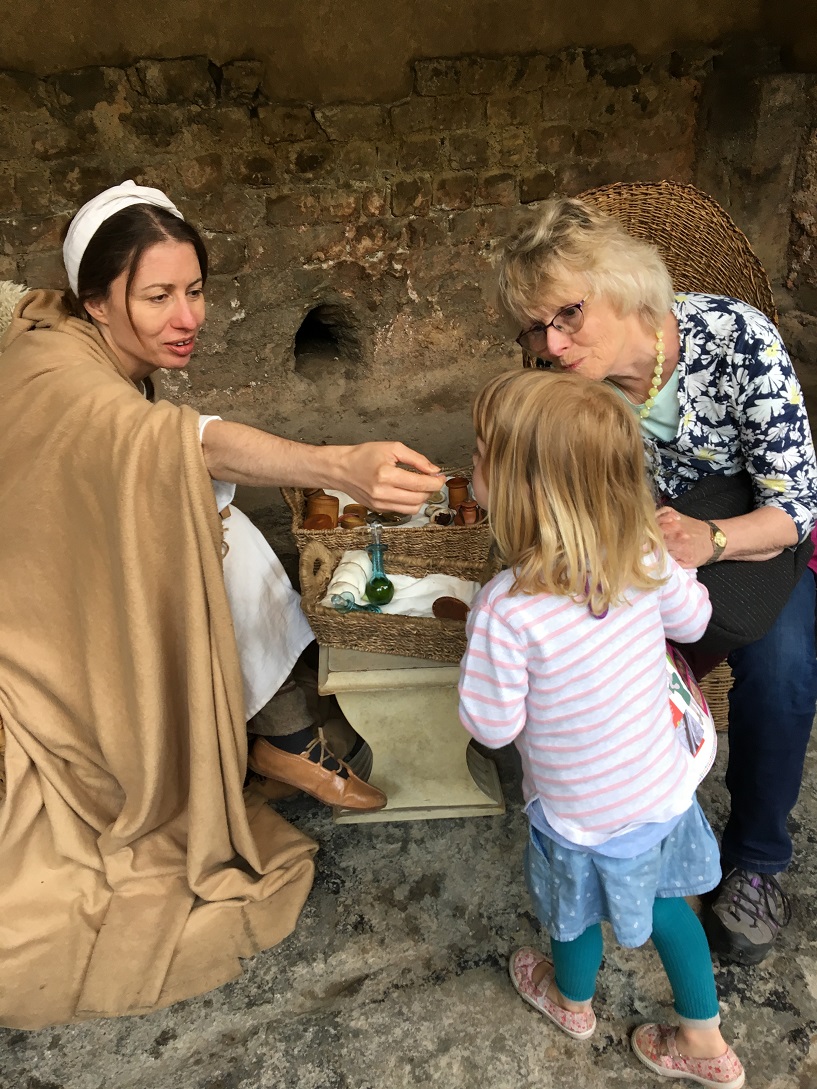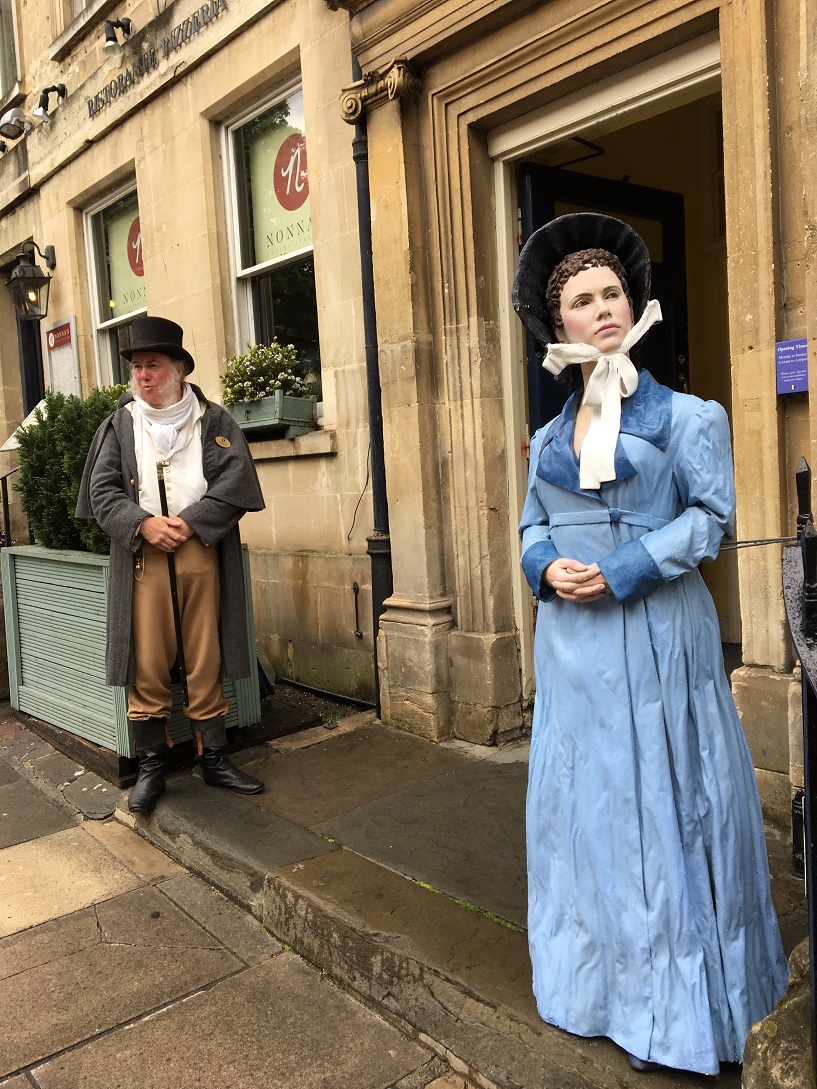‘Taking the Waters’ in Ancient Bath, England


By Eileen Ogintz
BATH, England — “Do you have a slave?” the haughty “Roman Lady” asked the kids. “She does everything for me, even puts on my makeup.”
They looked at her as if she were nuts. But then again, we were in “ancient Rome,” 2000 years ago where slavery was a way of life.
The “slave” shows the kids how she would make eye shadow from ground ocher and has them smell the perfumes the lady preferred.
We’re in the heart of the World Heritage Site of Bath—the entire city is a world heritage site—in the best preserved ancient Roman baths and temple complex in northern Europe and today a remarkable museum with the UK’s only thermal springs.
People have been coming here to “take the waters” since the Romans first built the baths and temple here to worship Sulis Minerva, Goddess of the Thermal Spring. We see the coins thrown into the Sacred Spring and all kinds of other treasures that have been found—inscriptions recording how locals and well-traveled pilgrims lived, pottery from religious ceremonies, jewelry and “curses” thrown in against those who had done wrong. It was an immense complex and today a museum where thanks to 21st Century technology, visitors can “see” what life was like not only from the historical impersonators but also images super imposed on the walls and here them with the audio guide. We listen as bathers first sweat in the hot pool and then jump into the icy pool, as was customary.

Today, the water still bubbles up and people still come to take the waters—in this case at the newly expanded Thermae Bath Spa a few blocks away where people were waiting in line two hours for the chance to soak in the thermal rooftop pool and experience the New Royal Bath, the Minerva Bath named after the Roman Goddess of Health and Wisdom with grand columns a massage whirlpool and lazy river.
There is a Springs Café restaurant — just as in Roman times people gathered at the spa to gossip , relax and do business as well as for religious ceremonies. Here there are wellness treatments—everything from massage to facials to body scrubs and water treatments. (How about an olive and rose scrub then a warm nourishing rose oil and cream application to your skin followed by a rose facial?)
In the new Wellness Suite there are Roman inspired steam rooms, one with relaxation couches and twinkling lights, an infrared sauna, ice chamber and more.
No wonder on a rainy Saturday people who hadn’t pre-booked spa treatments (reasonably priced starting at less than $75) were patiently waiting in line two hours to get in for the privilege of spending a couple of hours in the pools (less than $50). Some were celebrating birthdays; others bachelorette parties.
Megan Willis, celebrating her 21st birthday, grew up in Bath but has never been here.
Nicola Fulton, a soon to be bride from London was surprised when her friends brought her here as part of her bachelorette weekend. “I know nothing about it,” she said.
“It’s so worth it when you get in,” said Christina Hyams, one of the group who had come 130 miles from Kent for the weekend.
We thought so, though we didn’t need to wait we relaxed in the different pools and “wellness suite.”

Bath today a thriving city of more than 100,000 with two universities and some 20,000 students, is a popular tourist draw for Brits and foreigners alike. It is an easy 1 hour and 20 minute train ride from Paddington Station (get tickets via The Trainline, Europe’s leading independent seller of train tickets).
People come to see the medieval cathedral, the quaint shops and the sense of Georgian English society which Jane Austen –2017 marks the 200th anniversary of her death—documented and satirized so ably in her famous books. She visited Bath an then lived here for several years and took a lot of inspiration from the rituals of “society,” explained Andrew Butterworth, who oversees a student abroad program here, teaches and leads Austen courses and tours.
There is a Jane Austen Centre (try on 18th century bonnets here and at the Fashion Museum!), the chance to parade in the public gardens as fashionable Bath did or gossip in the Pump Room where people came to drink the mineral water and now come for lunch or tea. In those days, it was fashionable for people to come to take the waters to shop, to gossip just as it is today, Butterworth said over tea. A thousand people might go to The Assembly Rooms for a dance or a concert.
We had lunch overlooking the ancient Baths in a converted Georgian house with a warren of small rooms at the Roman Baths kitchen where we had terrific fish and chips and a thoroughly modern “super salad” with Quinoa, beets, avocado, sweet potato and harissa yogurt dressing. There was flatbread with beet hummus, locally sourced charcuterie and a local pork and pistachio terrine.
Despite the rain, visitors were shopping on the cobbled streets. “You have to walk in Bath,” said Butterworth. They visited the Bath Abbey and the Royal Crescent. And wandered down the side streets and alleyways with tiny shops and cafes.
“That’s what people miss,” said Mara Willis, 20, who has grown up here. “There’s a lot of history but you don’t want to miss the little things!”
